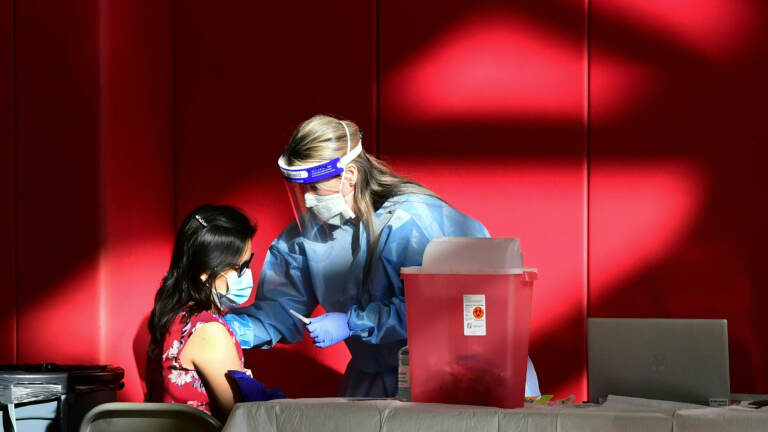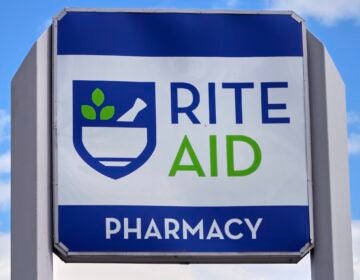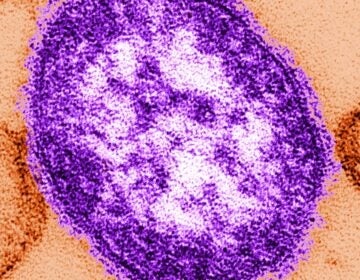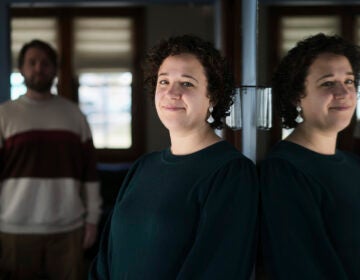Ready to get the COVID vaccine? Here’s how to book it in your state

How do you get a COVID-19 vaccine appointment? The answer varies by state. (Frederic J. Brown/AFP via Getty Images)
Updated May 4, 1:20 p.m. ET
Eligibility for the COVID-19 vaccine has rapidly expanded in recent weeks. As of April 19, everyone over age 16 is eligible to get vaccinated in every state. But how are you supposed to sign up?
In late April, the Biden administration launched a few centralized tools to help with the process. You can look up your zip code and see a map of vaccine providers near you at Vaccines.gov — the Spanish-language version of the website is Vacunas.gov.
And you can get help via text: If you text your zip code to GETVAX (for English) or VACUNA (for Spanish) you will get a message back with three possible vaccination sites, with phone numbers to call for an appointment.
But some aspects of the vaccination campaign vary by place, so NPR created a tool to guide you through the process in your state and connect you with local resources. And we’re sharing advice for navigating the system below.
Search for your state below. (There are a few large cities with their own immunization plans that you’ll find on our list as well.)
Please note that the information in this tool is subject to change, as states roll out new processes and new providers get the vaccine. Always check with your state health department for the latest guidance.
Advice for navigating a patchwork system
It helps to understand how the system works as you set out to get the vaccine. Here are some tips to keep in mind as you proceed.
1. Understand the big picture. As you try to navigate the vaccine system in your state, be aware that there are often multiple points of entry for those seeking a vaccine. Although the federal government pays for and distributes the vaccines, it’s up to state and local health departments and the private sector — hospitals, clinics and pharmacies — to actually schedule and give out the shots.
In many states, the different systems don’t talk to one another. So when it’s your turn to get signed up for a shot, you may need to look for available appointments in all of these separate streams, depending on your state.
2. Keep an eye on pharmacies. In addition to sending vaccines to states, the government is sending vaccines directly to chain pharmacies through the Federal Retail Pharmacy Program, which launched in early February.
Find out which pharmacies in your area are giving out vaccines by looking up your zip code at Vaccines.gov, the federal government’s map of COVID-19 vaccine providers. Once you select a provider near you with doses in stock, you can often click through from the map to book an appointment, or call to ask if they accept walk-ins.
3. Remember that the vaccine is free. You can get it at no cost if you don’t have insurance. If you are insured, your insurance plan has to cover the costs of administering the shot. Make sure to have your health insurance info handy when looking for an available slot in case that information is needed to register.
4. You may be able to get a walk-up appointment, with a few things in hand. In many places around the country, the balance has now tipped, and there are more doses and available appointments than there are people lining up to get vaccinated. Because of this, many state and local public health departments now have mass vaccination or pop-up sites that don’t require any appointment-booking or registration at all.
To find the location and hours of walk-in vaccination sites that would be convenient for you, use NPR’s lookup tool for links to your state public health website, where there should be info about times and locations accepting walk-ins.
Usually, people are encouraged to bring a photo ID and health insurance information (so the vaccinators can be reimbursed for giving you the shot), but you can still get vaccinated even if you’re uninsured or don’t have a driver’s license. Check before you go to see if your local site has instructions on what to bring.
5. Look for local advice. Some tips that can help you find a slot are specific to a local area or state. You can find local guides from the media or places like the AARP and GoodRx. Follow your state and local governments on social media for specific tips related to where you live and maybe news about mass vaccination sites opening up with available slots.
Also search for Vaccine Hunting Facebook groups — like this one in South Florida or this one in Oklahoma — and other local volunteer efforts that have sprung up to try to help folks navigate all of this.
Why is it so confusing, anyway?
The vaccine distribution patchwork is not easy to fix because it’s a reflection of the patchwork health care system, a mix of public providers like health departments and private providers like hospitals and clinics that don’t always play nice together.
“I can’t tell you how complicated it is to have a federally financed vaccine being distributed through a state-based system, with a health care system that’s private sector based,” says Claire Hannan, who runs the Association of Immunization Managers. “These three things are completely separate and operate in their own kingdoms. So, trying to marry all of this and to track it in real time with data connections? It’s incredible that we are where we are.”
Many public health experts say they wish Vaccines.gov and other centralized tools were available at the beginning of the vaccination campaign, but hope that they can still help people who are still considering getting vaccinated, but aren’t sure how to do it or where to go.
Audrey Carlsen designed and developed this look-up tool; Rhitu Chatterjee, Deborah Franklin, Maria Godoy, Richard Harris, Pien Huang, Kristen Kendrick, Rosemary Misdary, Yuki Noguchi, Akilah Wise, Julia Wohl and Carmel Wroth contributed research and reporting.
9(MDAzMzI1ODY3MDEyMzkzOTE3NjIxNDg3MQ001))




